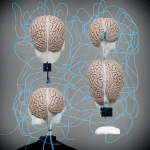The human brain is an intricate organ, an enigma that continues to stump even the most brilliant of scholars. As the command center for the entire human body, maintaining its health is crucial. Over the years, technology has greatly evolved to offer a vast array of treatments that aim to enhance brain health and function. One such revolutionary advancement is the advent of non-invasive brain stimulation therapies. A sector that’s been gaining significant traction in the realms of both treatment and research, non-invasive brain stimulation therapies have shown remarkable progress. With keywords such as tDCS, TMS, and NIBS becoming increasingly more common, it’s clear to see that these therapies have grown beyond their nascent stages.
The Emergence of Transcranial Magnetic Stimulation (TMS)
Transcranial Magnetic Stimulation, or TMS for short, has gradually established itself as a prominent player in the arena of non-invasive brain stimulation therapies. This technology employs the usage of magnetic fields to stimulate nerve cells in your brain, particularly those regions that are associated with mood control and depression.
Sujet a lire : How Is the Metaverse Influencing Online Social Interactions and Commerce?
This process involves delivering repetitive magnetic pulses to the brain. It’s an effective and safe way to treat severe depression, especially in patients who’ve not responded well to traditional therapeutic methods. TMS has proven to be a game-changer for depression treatment, allowing patients to experience marked improvements in their mental health without having to bear the burden of invasive procedures.
The Rise of Transcranial Direct Current Stimulation (tDCS)
The second major form of non-invasive brain stimulation therapy that has recently gained traction is Transcranial Direct Current Stimulation, or tDCS. This procedure involves sending small electrical currents to your brain through electrodes that are placed on your head.
A lire aussi : Can Technology Help Preserve Linguistic Diversity and Endangered Languages?
While the underlying method of tDCS may sound quite similar to TMS, there are key differences that set these two treatments apart. tDCS typically utilizes a lower intensity current, making it a milder yet equally effective form of therapy. This treatment has risen in popularity due to its potential to enhance cognitive abilities, including memory and learning skills. It’s also been noted for its effectiveness in treating a range of mood disorders, not just depression.
Non-Invasive Brain Stimulation (NIBS) and Its Advancements
Non-Invasive Brain Stimulation (NIBS) is an overarching term encompassing both TMS and tDCS, along with other forms of brain stimulation therapies. This field has seen significant advancements in recent years, with new techniques like transcranial alternating current stimulation (tACS) and transcranial random noise stimulation (tRNS) entering the fray.
These newer methods have given researchers more tools to understand the intricate workings of the brain and offer even more targeted and effective treatments. As the field of NIBS continues to expand and evolve, it’s anticipated that these therapies will become increasingly personalized, catering to the unique needs of each patient.
The Role of Scholars, Google, and Crossref in Advancing These Technologies
Scholars, search engines like Google, and citation databases like Crossref play a critical role in advancing the field of non-invasive brain stimulation therapies. Scholars conduct the vital research required to develop these technologies, while platforms like Google and Crossref ensure that this research is accessible and well-documented.
Google’s influence particularly is seen in how it makes scientific literature easily searchable and accessible to the public. Crossref, on the other hand, plays a key role in linking scholarly works together, thereby ensuring that researchers are able to build upon each other’s work efficiently and effectively.
The Future of Non-Invasive Brain Stimulation Therapies
As we look towards the future, it’s clear that the field of non-invasive brain stimulation therapies has a lot of potential. With rapid advancements in technology and a growing body of clinical evidence supporting their effectiveness, these therapies are poised to transform the landscape of brain health.
The use of these technologies isn’t limited to treatment, either. They’re also serving as valuable tools for cognitive enhancement, potentially ushering in a new era of human performance. As researchers continue to refine these therapies and uncover new areas of application, the possibilities for non-invasive brain stimulation are seemingly endless.
The Impact of Non-Invasive Brain Stimulation Therapies on Mental Health and Neurological Conditions
Many revolutionary advancements in brain health are centered around non-invasive brain stimulation therapies, which have shown immense promise in treating various mental health disorders and neurological conditions. These therapies, like Transcranial Magnetic Stimulation (TMS) and Transcranial Direct Current Stimulation (tDCS), are now gaining significant recognition in the field of mental health.
TMS, in particular, has proven to be a boon for patients suffering from severe depression, who have not responded to conventional treatment methods. By delivering repetitive magnetic pulses to specific regions of the brain associated with mood control, TMS has shown to bring about marked improvements in patient’s mental health. The non-invasive nature of TMS makes it an attractive alternative to invasive procedures.
Likewise, tDCS, which involves the delivery of small electrical currents to the brain, has demonstrated success in enhancing cognitive abilities such as memory and learning. Additionally, this therapy is not confined to treating depression but is effective in managing a range of mood disorders. The lower intensity of the current used in tDCS compared to TMS makes it a milder form of therapy which is equally effective.
The advancements in Non-Invasive Brain Stimulation (NIBS) therapies, which include TMS and tDCS, offer hope to many patients dealing with mental health issues and neurological conditions like Parkinson’s disease. Furthermore, with the advent of new techniques like transcranial alternating current stimulation (tACS) and transcranial random noise stimulation (tRNS), there are more therapeutic options available to patients than ever before.
The Role of Google Scholar and Meta-analysis in Advancing Non-Invasive Brain Stimulation Therapies
Google Scholar and Meta-analysis play crucial roles in advancing the field of non-invasive brain stimulation therapies. Google Scholar is instrumental in making research studies and scientific literature accessible to the public, thereby disseminating information about these therapies to a wider audience. This accessibility encourages transparency and fosters an environment where information is freely available, promoting further research and innovation.
Meta-analysis, on the other hand, is a systematic method of analyzing data from multiple independent studies on the same subject. In the context of non-invasive brain stimulation therapies, a meta-analysis can provide a comprehensive review of the effectiveness and side effects of these therapies. This helps in establishing their credibility and safety, prompting their wider acceptance and usage.
Conclusion: The Infinite Possibilities of Non-Invasive Brain Stimulation Therapies
The field of non-invasive brain stimulation therapies holds infinite possibilities for the future. With advances in technology and a growing body of evidence supporting their effectiveness, these therapies are set to revolutionize the way we think about mental health and neurological conditions.
The influence of platforms like Google Scholar and Meta-analysis is undeniable in advancing these therapies. By making research easily accessible and providing a thorough and systematic review of the available data, they help in shaping the future of these therapies.
As non-invasive brain stimulation therapies continue to evolve, we can anticipate a future where these treatments are not only used to manage and improve mental health conditions but also to enhance cognitive abilities. This opens up a whole new world of possibilities where the human brain’s potential can be unlocked and utilized to its fullest. The ongoing research and advancements in this field are testament to the exciting future that lies ahead.











